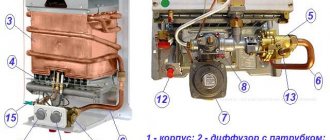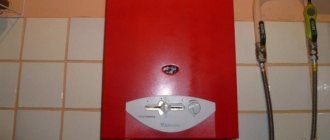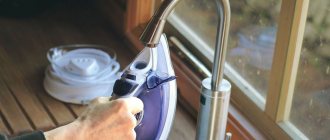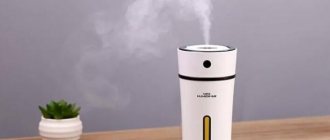To ensure a regular supply of hot water for their home or apartment, many owners install a gas water heater in the kitchen. The device is compact, does not take up much space on the wall, and even a teenager can understand the principle of operation.
Such water heating equipment will serve its owner “faithfully” for decades, but only with proper operation and periodic cleaning. How to rinse and clean a gas water heater with your own hands at home (for example, the Zanussi GWH 10 Fonte Glass Rialto model)? Detailed information is provided in the article.
Why do the “insides” of the gas water heater become clogged?
The reason for such contamination lies in the operating principle of the device. The device heats water using gas, and therefore accumulations of soot and deposits cannot be avoided. In addition, the incendiary element itself very often becomes dirty, collecting soot on its wick.
But the real apocalypse comes when scale “settles” in the water heater pipes. It not only interferes with the normal operation of the equipment, but can even disable it completely, completely clogging the water supply part. The appearance of scale in the heat exchanger is especially dangerous.
The heat exchanger is a collection of tubes placed above a gas burner. Water must flow through them constantly and unhindered; it is in them that it heats up evenly. When scale accumulates in these pipes, interruptions in the supply of hot water occur.
You might be interested in: 9 important questions when choosing a geyser
How does such a unit work?
When cleaning the Neva gas water heater with your own hands and other brands, you need to take into account the design features of such units. Visually, they look like a large iron box with pipes – one for gas, the other for cold water.
Inside the case there are:
- Igniter;
- Burner;
- Heat exchanger for hot water supply.
The unit operates as follows. First, the user opens the hot water tap, at which time the ignition in the column is automatically turned on. The igniter is turned on - it ignites the main burner, and it begins to heat cold water in the heat exchanger until the set temperatures are reached. A similar principle is used by most boiler models.
Important! On a gas water heater, ignition can be electric or piezo.
From a design point of view, modern heat exchangers are extremely well thought out. For example, the heat exchanger from the column has the shape of a coil (spiral), which guarantees the fastest heating of the water before it is supplied to the tap. Combustion products are immediately removed from the room through the chimney into the ventilation. Cheap models do not always contain output, which is their main drawback. Therefore, when choosing equipment, take into account all the main factors - this will help you make the only right choice of equipment and prevent unnecessary expenses in the future.
It's time to cleanse: the first signs
You can determine that a geyser (for example, from Bosch) needs cleaning based on 4 characteristic signs:
- The device stops turning on or often goes out during operation . When there is 100% confidence that gas is supplied to the column uninterruptedly, and water flows with a stable pressure, the reason for such independent shutdowns may be an excessive amount of burning on the ignition element. The problem can only be resolved by cleaning the burner.
- The thermal protection of the device is activated . To prevent the column from overheating, the equipment is equipped with a thermal sensor. It signals an increase in temperature, warning the owner of a malfunction. If this sensor is triggered frequently, it is worth cleaning the pipes from scale. Since scale has good thermal insulation, it interferes with the normal cooling of the device.
- The productivity of the device has decreased for no apparent reason . If the water begins to heat up more slowly or the pressure level drops significantly, you need to check the heat exchanger for scale and clean out the accumulated products of the column.
So, it’s clear that the device is dirty, but how can you clean the geyser from scale and soot when such a need arises? The answers are in the following sections of the article.
Operating principle of instantaneous water heater
A gas water heater is a relatively simple device for heating water. On top there is a heat exchanger connected to the water supply system. Underneath there is a burner, which is connected to a gas pipe.
In all modern models, burner ignition is automated; only very old or faulty models are ignited manually. It is better to repair the latter so as not to risk the health of your family and the integrity of your property.
The design is hidden by a protective casing, on the front panel of which the control unit is usually located. It regulates the maximum temperature of water heating, the amount of gas and other indicators of the operation of the device. On top there is a hood and a chimney pipe through which combustion products are removed.
When the water is turned on in the house, the burner automatically turns on and the gas heats the water to the required temperature. Auto-ignition is configured in such a way that the column turns on only when the water pressure in the system is sufficiently high. Another important indicator is the presence of good traction.
Before starting work on cleaning a household geyser, you need to get acquainted with the structure of the device in order to disassemble it correctly
The process of heating water is accompanied by the precipitation of hard sediment, which gradually accumulates inside the heat exchanger. The tubes become clogged with deposits, as a result the quality of heating deteriorates and the operation of the instantaneous water heater becomes insufficiently efficient.
Regular cleaning of the column will help avoid such problems. In addition to scale, other contaminants can accumulate inside the device, it all depends on the quality of the water.
A household geyser is not particularly complicated: water moves through the heat exchanger pipe, it is heated by a burner, and the ignition is turned on automatically
The following signs indicate that it is time to clean the column:
- the pressure from a hot water tap is much weaker than the stream from a cold tap;
- the pressure is good, but almost immediately after switching on the column goes out;
- the device stopped turning on altogether, regardless of the pressure;
- there is insufficient heating of the flow compared to the previous state;
- The water heats up to the desired temperature, but too slowly.
Some malfunctions can also be observed when the shut-off valve, which is installed at the entrance to the dispenser, breaks down. It doesn’t hurt to check it first, and only then start cleaning.
Gas water heater cleaning products
The rules for caring for a gas water heater are described in detail in the instructions for the device, and deviating from these requirements can be dangerous. If the water heater suddenly becomes clogged, you should use only products recommended by the manufacturer to clean it. They should also be indicated in the relevant paragraphs of the instruction manual. And it is better to entrust the cleaning process to professionals. In this case, not only will the blockage be eliminated, but the warranty will also be preserved.
Important ! Unauthorized reading using unauthorized means is dangerous to health! If during the process of descaling or burning one of the elements of the column is damaged and a gas leak appears, you must immediately call 104.
Only if the user understands all the possible consequences and accepts responsibility can he clean the device himself. What and how to rinse a geyser (for example, Ariston brand) from scale in this case? You can also use ready-made drugs or traditional methods. What is better and more effective: “vigorous” chemistry or “grandmother’s” cleaning, the comparison table will show:
| Solves the problem | Folk remedy | Chemical drug |
| Scale inside the heat exchanger | A mixture of 0.5 liters of hot water and 100 g of citric acid. | Calgon or Antiscale (corrodes layers of scale inside pipes). |
| A dense layer of carbon deposits (can only be removed from the heat exchanger; the gas part is cleaned by specialists) | Dilute table vinegar and warm water in a ratio of 1:3. | You can use 7-10% hydrochloric acid or other strong chemicals. Important! The work requires care: under no circumstances should the product come into contact with the skin or mucous membranes. |
How to descale a column
What kind of products do not the owners of private houses and apartments use when cleaning geysers with their own hands - various acids, household chemicals and even electrolyte from batteries. We warn you: most of these compounds are unsuitable for servicing water heating devices; their use will not give results, and can easily cause harm.
We will recommend 2 products whose effectiveness has been tested in practice and confirmed by numerous user reviews:
- An inexpensive powder sold in grocery stores is food-grade citric acid. 50-70 grams of product are diluted in 1 liter of washing water.
- Special liquids designed for cleaning the coils of geysers and plate heat exchangers of double-circuit boilers from scale.
Note. In particularly advanced cases, it is allowed to increase the concentration of citric acid to 100 grams / 1 liter.
Scale is a combination of salts of various metals, representing solid deposits of a light shade. Hydrochloric, sulfuric or acetic acid weakly dissolves this substance, but happily “eats” copper. But the cheap “lemon” works flawlessly, as you can see by watching the comparison video:
Descaling: work order
To carry out such manipulation, you can use both folk remedies and chemical solutions. Having cast your vote in favor of chemistry, you must follow the instructions exactly. If you choose citric acid or vinegar, then the work consists of the following steps:
- the gas water heater is turned off;
- the heat exchanger is disconnected by hand from the remaining elements and removed from the wall, the water is drained from it;
- at the same time connect a hose to the pipe that supplies water to the column to avoid leaks;
- using a bulb, syringe or watering can, the resulting solution is poured into the heat exchanger pipes;
- Now the heat exchanger body is lowered into a deep basin with the same mixture and left in this state for several hours or overnight.
After this, the part must be rinsed well under running water, connected back to the column (optionally, the column of the Ariston FAST R ONM model) and then start the device. Pressurized water will remove all scale, leaving the pipes perfectly clean.
Nuance : It’s easy to check the effectiveness of your work - just look at the color of the water: if it is transparent, then all the scale has come out.
Anyone who dreams of a new device will be interested in reading: Replacing an old gas water heater with a new one: 5 important points
Option for cleaning the water intake unit
We figured out how to clean the burner of a gas water heater, what to use and how to flush the radiator. The last point in the review is cleaning the water inlet assembly. It contains a strainer that prevents large pieces of rust and other deposits from clogging the pipes. It is imperative to check the membrane tension - if it is insufficient, there will not be sufficient draft from the gas water heater after turning on the water tap.
How to clean the column if the water intake unit is clogged:
- Remove the unit from the device.
- Unscrew the screw part and open the housing.
- Clean the filter under a powerful running stream of water.
- Check the membrane - if there are bulges, the part has served its purpose and needs to be replaced, it would be best to install a silicone product.
- Close the water inlet cover, preferably using screws. This will ensure maximum uniform tension.
You can only clean the jet nozzles yourself - in other situations you will need the help of a professional technician. The plumbing component is not so complicated and allows for “household” interventions. The main thing is to follow the basic rules and follow the established standards of work.
Is it possible to clean the heat exchanger without dismantling it?
The immediate answer is: “Yes, you can.” To do this, you need to remove the front protective panel and disconnect the heat exchanger from the pipe that supplies water to the gas water heater. A drain hose is connected in its place.
When these preparatory procedures are completed, any chemical agent (or folk composition, if desired) is taken and poured into the heat exchanger pipes through the inlet. You should fill the “insides” slowly, in a thin stream, to avoid a sharp reaction and pushing the product back out.
The device is left in this form for 2-3 hours. After the time has passed, you need to reconnect the hose and drain the waste water with scale and other impurities. Then turn on the column and check its operation.
Why does soot appear?
Caring for the speaker primarily involves cleaning it from soot. You can perform the procedure yourself, using a cleaning product and following simple rules, or contact a specialist. Clogged nozzle holes can be easily pierced with a wire brush or thin wire.
The column needs to be cleaned regularly - according to reviews, the nozzles in most models clog quickly, and the igniter also requires regular maintenance. Regular cleaning of the igniter of a Bosch and other brands of gas water heater will avoid costly repairs in the future, since this procedure extends the life of the unit.
Every equipment owner should know how to clean the burner in a gas water heater, since problems with igniters occur in models. But if the device constantly goes out, for unknown reasons, and nothing helps, it would be better to contact service.
Soot may appear due to leaks in the gas supply pipe. With a minimal release of gas masses, there will be practically no odor, and the user will not understand anything. You can check the system like this - apply a soap solution to the pipe connection areas with a brush, turn on the column and see how it behaves. If bubbles appear, there is a problem. Options for how to clean a gas water heater at home will not help here - call a gas technician.
The next potential problem area is a clogged radiator. It often causes increased accumulation of soot. The easiest way to clean a speaker radiator is with a vacuum cleaner; any model will do.
Turn off the gas supply, remove the casing from the column, and remove the soot. If this still doesn’t help, check the draft by turning off the gas and holding a lighter or candle. Normally, the flame should deflect or go out. If the candle burns as if nothing had happened, the chimney needs cleaning. When the device has a forced draft fan, such problems do not arise in principle.
Removing soot and soot
It is better to entrust cleaning of a gas water heater (for example, the Bosch Therm 4000 O WR model) from combustion products, as well as from scale, to professionals, especially when the device is under warranty. You can independently remove only soot from the surface of parts without disassembling the gas part. How to do it? The process takes 10-15 minutes and consists of the following steps:
- the gas supply is turned off and the upper housing is removed;
- all internal elements are carefully wiped with a cloth or cleaned with a vacuum cleaner;
- the casing is installed back and the functionality of the device is checked.
If the gas wick starts to burn weakly, it means the nozzle is clogged. It is located on the gas manifold, next to the pressure sensor. You can clean the nozzle with a regular thin wire and a stiff brush. Upon completion of work, be sure to check the element for gas leaks. To do this, you need to lubricate the burner with soapy water (bubbles appear when there is a leak).
How to remove soot from a heat exchanger
We wrote above where the heat exchanger is located; before starting maintenance, it is advisable to remove it from the unit, first turning off the gas and water, opening the tap for supplying hot water (the one located near the flow-through heater). Then, using a gas or open-end wrench, loosen the nut securing the tube to the water unit and unscrew it slightly (a couple of turns will be enough). The contents must be allowed to flow out through the mixer, which is left open.
Helpful advice. Before cleaning the geyser from scale, prepare a special tool and products. The most convenient way to solve the problem is to use an aerosol agent to loosen boiled threaded joints. You can ask for the WD40 product at any auto store or hardware store.
How to clean the geyser heat exchanger further:
- Unscrew a couple of union nuts and dismantle the assembly.
- Disassemble other elements and parts that prevent easy dismantling. Their number depends on the specific model and design features of the column. In some cases, it is necessary to remove the smoke exhaust diffuser, in others - the ignition group, in others - overheating and draft sensors. You may have to remove all the parts.
- Cover the burner nozzles with a cloth to prevent soot from getting into them.
- Take the heat exchanger to the bathroom, thoroughly clean it with a long-bristled brush to remove all soot, rinse and dry.
- Return the unit to its place and reassemble the unit in the reverse order described above.
Do not forget to install new seal rings at the pipe connections. Cleaning a geyser is not difficult; most of the time is spent on assembly and disassembly. Work must be carried out strictly according to the rules. If you are not sure that you will do everything as needed, call a specialist.
Helpful advice. If the installation is clogged, you have already removed the heat exchanger, it makes sense to immediately rinse and clean the gas water heater from scale. Maintenance will be more efficient and will not take much extra time.
Before starting the unit, you need to check it for leaks. To do this, open the water supply tap and wait until the heat exchanger is filled from the open mixing tap. Then the supply is closed again, and the unit is inspected to determine the degree of permeability of its connections. If there are no serious problems, the gas valve is re-opened and the apparatus is started up for testing in standard operating mode.
Use liquid for flushing and softening connections during maintenance at your discretion. Chemistry simplifies the work, but it is not necessary to use it.
Flushing helps not only from carbon deposits, but also from dust.
Prevention is better than cleaning
Prevention is necessary to prevent scale, which is the main scourge of geysers (for example, such as Zanussi water heaters). It appears not only as a result of salt deposits from hard water, but also as a result of constant high temperature in the device. To ensure that the pipes are clogged with this “muck” as little as possible, it is necessary to set the optimal temperature.
Another way to prevent scale is to install water purification filters or electric softeners. They do not allow harmful salts to pass through, allowing the heat exchanger pipes to last longer. However, the cleanliness of the filter and electric softener also needs to be monitored.
You might be interested in: TOP 10 geysers of 2017
Causes and consequences of scale formation
In private houses with a central water supply, water that has undergone disinfection and rough cleaning is used as a coolant for hot water supply and heating. This coolant contains large quantities of various suspended substances, including Ca and Mg, which, under the influence of high temperatures, more than 65 ° C, due to malfunction of the geyser modules, unsatisfactory water pressure, fall into carbonate sediment (CaCO3, MgCO3). Such deposits are called scale.
The scale adheres firmly to the metal surface inside the heat exchanger, pipeline, etc.
Low thermal conductivity of scale and good adhesion leads to:
- overheating of the tubes and plates of the heat exchanger, up to its damage;
- overconsumption of energy resources;
- reduction of water consumption due to overgrowing of internal pipeline channels and water heater elements;
- clogging of valves, taps and other system elements;
- reducing the thermal power of the device.
Over time, the outer part of the heat exchanger becomes covered with fuel combustion products. The formation of soot is promoted by the intense flame of a gas burner, poor draft in the chimney, unsatisfactory gas-to-air ratio, increased content of additional impurities in the fuel, and the ingress of contaminated condensate from the chimney. Soot affects heat exchange and leads to increased gas and water consumption.
When should you clean?
Information about the frequency of cleaning geysers is quite contradictory. Some sources on the Internet recommend maintenance annually, others – once every 6 months, and so on.
The homeowner will be guided correctly by the quality of tap water and some signs indicating that the device is dirty:
- heating efficiency and pressure in the DHW line have decreased - the heat exchanger is clogged;
- the pilot light burns with a yellow or red flame (should be blue);
- the color of the fire on the main burner also changed;
- the column does not ignite and turns off on its own at normal pressure in the network.
The average interval between preventive cleanings of instantaneous water heaters is 1 year. But the quality and hardness of the local water should be taken into account. If it is saturated with salts, scale will be deposited much faster.
In such cases, it is appropriate to use filter softeners, otherwise all water heating equipment will quickly become unusable.
Cleaning with complete disassembly
Do not be afraid to disassemble the water heating installation, the procedure is not that complicated. You will need the most common tools - screwdrivers, pliers, standard wrenches.
What to do before starting work:
- Close the taps of the cold water, hot water and gas supply pipelines. Unplug the turbocharged dispenser from the outlet.
- Substituting the container , unscrew the union nuts (American) on the connection of the water pipes. Disconnect the connections from the unit without losing the rubber gaskets.
- For convenience, it is recommended to remove the gas heater from the wall. It is not easy to disassemble and clean a unit that is hung too high or installed in a narrow niche.
- To dismantle the water heater, disconnect the gas line and the chimney pipe. Remove the unit from the hooks.
Lay the hot water column on a horizontal surface and proceed to further work, the order of which is outlined in our instructions.
How to remove the heat exchanger and column burner?
We will show the disassembly sequence using the example of a cheap Chinese Novatek water heater.
We present step-by-step instructions with photos:
- Remove the control handles mounted on the front panel. Unscrew 2 screws (or 2 plastic clips) and remove the device casing.
- The next step is to remove the smoke collector. To do this, disconnect the wires from the draft sensor and unscrew the screws holding the diffuser box.
- Disconnect the heat exchanger tube from the water unit by disassembling the connection with the union nut. The second pipe must be freed from the lock washer, pressed with 2 screws.
- Disconnect the burner from the gas valve by unscrewing the 2 screws on the flange. Having moved the radiator upward, carefully remove the burner device (pull towards you) and move it to the side.
- Unscrew all screws connecting the heat exchanger to the rear panel of the water heating unit.
- Pull out the radiator completely and remove the burner, disconnecting the wires along with the ignition electrodes.
Note. While removing the heat exchanger, disconnect the wires from the temperature sensor.
Disassembly of geysers from other manufacturers may differ, but not fundamentally. The order of work remains unchanged.
Let's list some important points:
- in a chimneyless turbo column, the fan will have to be removed;
- in units of the Italian brands Ariston (Ariston) and some others, the pipes are connected not with nuts, but with self-clamps;
- If the water heater is equipped with an igniter, then before removing the burner it is necessary to disconnect the gas tube connected to the wick.
Important! Be careful not to lose any rubber or other gaskets discovered during disassembly. Before assembling and installing the column, it is advisable to replace these seals with new ones.
Flushing procedure
This operation is very simple compared to disassembly - cleaning the gas water heater begins by immersing the heat exchanger in a container with washing liquid.
The procedure is as follows:
- Take a bucket or deep basin, fill it with water and prepare a cleaning solution according to the recipe on the package. The concentration of citric acid is 50-70 grams per 1 liter of liquid.
- Immerse the heat exchanger in the container with the radiator down and the pipes up.
- Using a watering can, fill the coil with detergent. Rinse it periodically by adding new solution.
- Flush the heat exchanger until clean liquid comes out of the tubes without scale flakes. Then run tap water through the coil to remove any remaining product or impurities.
Advice. Using citric acid, heat the solution to a temperature of 50-60 °C. The reaction will be more intense and end faster.
The removed burner can be cleaned from the outside and purged or washed with a solution of citric acid (no more than 50 grams per liter of water). Finally, rinse the element with running water, blow with compressed air and dry thoroughly.
Do not ignore other parts of the gas water heater - the mesh filter, smoke collector and combustion chamber, remove soot and other contaminants from them.
After washing and drying, put the heat exchanger back in place, connect the burner and follow the remaining steps to reassemble the water heater.
It is important to achieve tight connections: when installing old gaskets, treat them with high-temperature sealant. Check the joints for tightness using water pressure (4-6 bar).
It wouldn’t hurt to blow out the inside of the burner with compressed air at a pressure of 4-6 bar
For reference. The duration of washing depends on the thickness of the scale layer inside the column heat exchanger and ranges from 2-3 hours (prevention) to 2 days.
How to clean and how to rinse the filter
There are special products on sale for cleaning speakers, but many are accustomed to using improvised materials, which are not always suitable for this purpose. The most popular and effective means can be identified:
- hydrochloric acid (for copper tanks);
- lemon;
- vinegar 9%.
A solution is prepared from 100 citric acid in 500 ml of water. Cleaning liquid with vinegar is made in a ratio of 1:5. When using special products, you should read the instructions for preparing the solution on the packaging and act according to them. To clean the filter you need to:
- Turn off the water tap located under the device.
- Disassemble the column: remove the casing, some parts (depending on the model). A water unit is required for operation; it must be easily accessible.
- Place a container under the threaded connection for the liquid that will flow after it is separated. Unscrew the union nut on the left side of the water inlet.
- The filter looks like a mesh. You need to take it out, wash it, dry it slightly and put it back. You can treat the filter with plain running water, but if there are calcium deposits on it, you need to use a lemon juice solution.
Tip: To enhance the effect of citric acid, warm the liquid slightly before use.
Cleaning the water heater from soot
Fuel burnout products cover the lower surface of the radiator fins over time, this is facilitated by:
- long-term use of the maximum flame of gas burners;
- insufficient draft in the chimney pipe due to poor exhaust;
- poor ratio of gas and oxygen in the air, contributing to its incomplete combustion;
- excessive content of impurities in the gas mixture;
- drops of condensate containing soot on the radiator plates from the chimney.
Cleaning of soot is carried out when the area of contamination is more than 30%; in most cases it is combined with the elimination of scale. It is not necessary to call a professional to remove the soot layer from the radiator plates, but in order to save money, you will have to independently remove the heat exchanger from the water heater body, which is a task of average difficulty for the average person.
When carrying out this operation, you will need the following plumbing and household tools:
- An adjustable plumbing wrench, in rare cases a gas wrench (Bacho pipe wrench), designed to work with pipe nuts.
- Set of Phillips and flat screwdrivers, chisel.
- Pliers, pliers or round nose pliers.
- Consumables - paronite gaskets, flax fiber.
There is a wide range of geysers of domestic and foreign production on the market (Vector, Bosch, Astra, Neva, Oasis, Junkers, Termet, Electrolux), with the same operating principle, they have different assembly schemes, so we will focus on the general stages of their disassembly to remove the heat exchanger:
- Turn off the water and gas supply, remove the upper protective casing and handles, disconnect the water supply pipe from the heat exchanger, pulling out the locking latches and moving it to the side.
- Do the same with the outlet pipe of the coil, unscrewing the flexible line from it, remove the coarse filters from both outlets and put them aside.
- The reverse draft sensor is removed and moved to the side, the gas burner block is unscrewed from the frame of the unit and taken out.
- The fixing plate is snapped off the column body and the brackets holding the heat exchanger are removed, the additional screws securing the coil body are unscrewed, after which it is removed out and subjected to further cleaning.
Dismantling the heat exchanger of a water heating column
The heat exchanger can be easily cleaned of soot by yourself using the following methods:
- Place it in a plastic basin with warm water and add household dishwashing detergent to it, wipe off the oily soot deposit with a soft sponge.
- A good way to remove soot is laundry soap, grated and placed in hot water.
- When simultaneously cleaning soot and scale, a cleaning solution is poured into the inverted coil and left in this position for several hours - during this time the scale should completely dissolve in the anti-scale agent.
- Since the gas burner block is removed when the coil is dismantled, it can also be cleaned by placing it in a bowl of water and household dishwashing detergent and wiping the contaminated areas with a sponge. After cleaning, it is washed several times in warm water and dried thoroughly, otherwise water that gets into the small channels of the igniter and wicks will interfere with the passage of gas.
Cleaning the heat exchanger from soot











